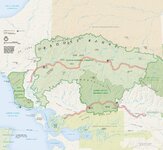First off, Seth Kantner makes some great observations in this op-ed:
We act as if we can do whatever we want, and these animals will be here for us. They won’t. That’s not the world we live in anymore.

www.adn.com
It's paywalled, but one of the points he made was about the 5-caribou bag limit PER DAY for locals, allowance still to take cows and calves, and how that seems to be contrary to sustaining the herd. He had proposed to the Board of Game to move to a 25 caribou annual limit per person, and here's a snippet from the op-ed on that:
"
The local advisory board shot me down on my proposals and finished off by accusing me of being racist. Afterwards, they brought up a favorite subject — fly-in sport hunters, Outsiders, who are hated and blamed here for delaying the fall migration — and then passed a resolution to send to the Board of Game supporting making it legal to shoot calves. This as a solution to the problem of so many calves orphaned after their mothers are shot."
The non-reporting by fed-qualified subsistence hunters is still a huge issue as well. And until we get better compliance with the actual law (everyone is required to pick up a permit and report, whether it's subsistence or state hunt), we really don't know what is going on with harvests by locals.
In the end, though, as Larry points out, the FSB is gonna likely impose some restrictions. But overall, the board is missing the forest for the trees, in what Kantner brings up. As much as locals want to make it about Outsiders or non-local hunters, they need to take a close look at themselves and the actions they are supporting and taking. I listened in to the last NW Arctic Regional Advisory Council meeting, and they were discussing the taking of cows. A couple people brought up that it would be pretty hypocritical to support continued taking of cows with the population in decline, whilst also supporting restrictions for non-locals, but thats the direction the RAC went.
I'm okay with restrictions when the herd is within the threshhold for conservative or preservative management. Which is where we are now in terms of overall numbers. But everyone has to sacrifice. Everyone. Locals are not doing much imo in terms of that...and I wish the FSB recognized and took note of that.



